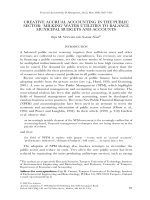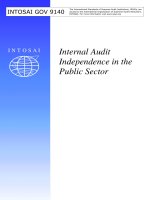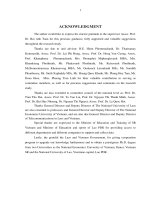Good Governance in the Public Sector— Consultation Draft for an International Framework
Bạn đang xem bản rút gọn của tài liệu. Xem và tải ngay bản đầy đủ của tài liệu tại đây (919.17 KB, 54 trang )
IFAC Board
Consultation Draft
June 2013
Comments due: September 17, 2013
Good Governance in the
Public Sector—
Consultation Draft for an
International Framework
This Consultation Draft of the proposed International Public Sector Governance Framework (International
Framework) has been developed jointly by the Chartered Institute of Public Finance and Accountancy
(CIPFA) and the International Federation of Accountants (IFAC).
CIPFA is the professional body for people in public finance. Its 14,000 members work throughout the
public services, in national audit agencies, in major accountancy firms, and in other bodies where public
money needs to be effectively and efficiently managed.
IFAC is the global organization for the accountancy profession, dedicated to serving the public interest by
strengthening the profession and contributing to the development of strong international economies. It is
comprised of 172 members and associates in 129 countries and jurisdictions, representing approximately
2.5 million accountants in public practice, education, government service, industry, and commerce.
Copyright © June 2013 by the International Federation of Accountants (IFAC). For copyright, trademark,
and permissions information, please see page 51.
REQUEST FOR COMMENTS
The draft International Framework sets out principles for each topic and creates a contextual background
for implementing good governance in public sector entities. A significant feature of this International
Framework is its explicit grounding in principles that can apply to entities of all sizes in the public sector.
The proposals in this Consultation Draft may be modified in light of comments received before being
issued in final form. Comments are requested by September 17, 2013.
Respondents are asked to submit their comments electronically through the IFAC website, using the
“Submit a Comment” link. Please submit comments in both a PDF and Word file. Please note that firsttime users must register to use this feature. All comments will be considered a matter of public record and
will ultimately be posted on the IFAC website. Although IFAC prefers that comments are submitted via its
website, comments can also be sent to Vincent Tophoff, IFAC Senior Technical Manager, at
This publication may be downloaded free of charge from the IFAC website, www.ifac.org, and the CIPFA
website, www.cipfa.org. The approved text is published in English. CIPFA and IFAC welcome translation
of this publication in other languages. Please refer to the Translations and Permissions section of the
IFAC website for policies, procedures, and an FAQ.
Guide for Commentators
The aim of this International Framework is to promote the development of robust governance by
establishing a benchmark for good governance in the public sector.
By encapsulating good practice within seven fundamental principles, the emphasis of this International
Framework is to support application of good practice principles rather than provide guidance on specific
governance measures.
IFAC and CIPFA request comments on all topics addressed in this proposed International Framework.
Anyone offering comments should refer to specific paragraphs, include the reasons for the comments,
and, where appropriate, make explicit suggestions for proposed changes to wording. Of particular interest
are comments on the matters set out below.
The terminology
1.
Do you support the proposed definition of governance, including how it is applied to define good
governance in the public sector? If not, how do you think it could be improved?
2.
Are the definitions used for other terms in Appendix C suitable for this International Framework? If
not, how do you think they could be improved? Should additional terms be included?
The implementation principles
3.
Do the principles cover all the fundamental areas of good governance for the public sector? If not,
how do you think they could be improved?
The guidance
4.
Is the commentary for each principle and sub-principle adequate to promote best practice? If not,
how could it be improved?
5.
Do the examples provided help explain how to apply the principles in practice? If not how could
they be improved? Can you suggest further examples that could be included?
6.
Do the evaluation questions for each principle help assess its application in practice? If not, how
could they be improved?
Other issues
7.
Do you have any other suggestions or recommendations for further improvement of this
International Framework?
8.
Are there any important resources missing from Appendix D?
4
INTERNATIONAL FRAMEWORK
GOOD GOVERNANCE IN THE PUBLIC SECTOR
CONTENTS
Page
Foreword ...............................................................................................................................
6
1. Introduction .....................................................................................................................
8
2. Key Principles of Good Governance in the Public Sector ..............................................
11
3. Guidance on Implementing the Good Governance Principles .......................................
13
A. Strong commitment to integrity, ethical values, and the rule of law .........................
13
B. Openness and comprehensive stakeholder engagement........................................
17
C. Defining outcomes in terms of sustainable economic, social, and environmental benefits
21
D. Determining the interventions necessary to optimize the achievement of
intended outcomes ..................................................................................................
24
E. Developing the capacity of the entity, including the capability of its leadership and
the individuals within it..............................................................................................
27
F. Managing risks and performance through robust internal control and strong public
financial management ..............................................................................................
33
G. Implementing good practices in transparency and reporting to deliver effective
accountability............................................................................................................
39
Appendix A: International Reference Group
Appendix B: Existing governance definitions
Appendix C: Definitions used
Appendix D: Important sources of information
5
GOOD GOVERNANCE IN THE PUBLIC SECTOR
Foreword
1
The public sector plays a major role in society. In most economies, public expenditure forms a significant
part of gross domestic product (GDP) and public sector entities are substantial employers and major
capital market participants. The public sector determines, usually through a political process, the
outcomes it wants to achieve and the different types of intervention. These include enacting legislation or
regulations; delivering goods and services; redistributing income through mechanisms such as taxation or
social security payments; and the ownership of assets or entities, such as state owned enterprises.
Governments also have a role in promoting fairness, peace and order, and sound international relations.
Effective governance in the public sector encourages better decision making and the efficient use of
resources and strengthens accountability for the stewardship of those resources. Effective governance is
characterized by robust scrutiny, which provides important pressures for improving public sector
performance and tackling corruption. Effective governance can improve management, leading to more
effective implementation of the chosen interventions, better service delivery, and, ultimately, better
2
outcomes. People’s lives are thereby improved.
Characteristics of the public sector
In order to fulfill its wide range of functions, the public sector must satisfy a complex range of political,
economic, social, and environmental objectives. This subjects it to a different set of external and internal
constraints and incentives from those in the private sector, all of which affect its governance
arrangements.
Generally, the main objective of public sector entities is to achieve outcomes—enhancing or maintaining
the well-being of citizens—rather than generating profits. Public sector entities often:
have a coordinating and leadership role to draw support from or foster consensus among all
sectors and society;
possess the power to regulate entities operating in certain sectors of the economy to safeguard and
promote the interests of citizens, residents, consumers, and other stakeholders and to achieve
sustainable benefits; and
undertake activities on a basis other than by fair exchange between willing buyers and sellers
because they have the ability to exercise sovereign powers. For example, pursuing social policies
may sometimes call for issues of equality and fairness to be given greater weight than financial
performance.
Financing public sector activities also has an important impact on governance:
the principal source of revenue for governments and, indirectly, many other public sector entities is
3
generally taxation;
taxation and other income streams are often separate from, and have little causal relationship with,
expenditure and service streams;
1
See appendix C for the definition of public sector and other terms.
2
IFAC Public Sector Committee, Governance in the Public Sector: A Governing Body Perspective (2001).
3
In some countries, the major source of income is profit from government owned companies.
6
GOOD GOVERNANCE IN THE PUBLIC SECTOR
public sector services may be provided in a non-competitive environment because alternative
providers often do not exist, and the bottom line does not normally determine the types of goods
and services to be provided; and
service recipients, unlike consumers in the private sector, may have little or no option to use a
different service provider or to withhold payment.
Stakeholders are therefore interested in issues such as (a) whether the planned outputs have been
delivered and outcomes achieved, and (b) whether this has been done in an efficient, economic, effective,
and equitable manner. They will also be interested in maintaining the entity’s capacity, as reflected, for
example, in the entity’s financial performance and financial position at year end. Public sector entities
should, therefore, be highly transparent, and provide high quality information about all aspects of
performance.
Framework purpose and development
The aim of Good Governance in the Public Sector (International Framework) is to encourage better
service delivery and improved accountability by establishing a benchmark for good governance in the
public sector. The International Framework is not intended to replace national and sectoral governance
codes. Instead, it is anticipated that those who develop and set national governance codes for the public
sector will refer to the International Framework in updating and reviewing their own codes. Where codes
and guidance do not exist, the International Framework will provide both a shared understanding of what
4
constitutes good governance in the public sector and a powerful stimulus for positive action.
This Consultation Draft was developed with input from an International Reference Group whose members
are listed in Appendix A. Their input was provided in their individual capacities and not as representatives
of their organizations. The draft was developed after an initial review of relevant current governance
literature. An overview of how the proposed International Framework maps to this literature is available on
the IFAC website.
4
The experiences this framework draws on were primarily gained in countries with liberal market economies where governments
are subject to regular election. It will, therefore, be easiest to apply its principles in a similar context. Nevertheless, CIPFA and
IFAC believe its concepts are capable of general application, even in the context of other political and economic systems—
wherever government provides services to achieve specifiable outcomes affecting its citizens reliably, effectively, and
efficiently. Consultation Question 5 seeks further examples from other jurisdictions.
7
GOOD GOVERNANCE IN THE PUBLIC SECTOR
1.
Introduction
Governance in the public sector
1.1.
There is no universally agreed-upon definition for the term “public sector governance.” What is
understood by the term appears to vary considerably between jurisdictions. Existing definitions of
governance, including those that are public sector focused, considered during the development of
the International Framework are included in Appendix B. For the purpose of this International
Framework, the following definition of governance has been adopted:
5
Governance comprises the arrangements put in place to ensure that the intended outcomes
for stakeholders are defined and achieved.
1.2.
The definitions of the other terms used throughout this document are set out in Appendix C.
Whole-system based approach
1.3.
Governments and other public sector entities raise resources from taxpayers, donors, lenders, and
other suppliers for the provision of services to citizens and other recipients, as well as less visible
activities, such as regulation and policy development. These entities are primarily accountable for
their management and use of resources to those that provide the resources and those that depend
on the resulting services. The resources raised are generally distributed through a network of public
sector entities with specific functions that have a range of accountability mechanisms. However, the
fundamentals of good governance should remain the same at all levels and stages.
1.4.
Most governance codes focus on delivering good governance practices at an organizational level.
This International Framework aims to be relevant not only at the individual entity level but also at
the whole-system level, which may be sub-national, national, or international. It draws on some of
the architecture maps in CIPFA’s Whole System Approach to Public Financial Management, which
outlines how the key constituent parts, such as external assurance and scrutiny, financial reporting,
and audit standards, contribute to the integrity of the whole system.
1.5.
The International Framework also adopts a “substance over form” approach, in that the
fundamentals of good governance should apply equally to a whole system within government, just
as much as to individual entities. As this may involve a number of individual organizations, the term
“entity” has been used instead of “organization” throughout this document.
1.6.
In some jurisdictions, governments or other public sector entities may fund and engage with entities
6
in the private and not-for-profit sectors to carry out certain activities or provide certain services.
While this International Framework does not specifically apply to governance arrangements in
these circumstances, the principles may also be relevant in such cases.
Principles-based framework
1.7.
As noted in the Foreword, the aim of this International Framework is to promote the development of
robust governance in public sector entities by establishing a benchmark for good governance.
1.8.
Public sector entities worldwide do not operate within a common legislative framework, nor do they
have standard organizational shapes or sizes. Therefore, in developing this International
5
Includes political, economic, social environmental, administrative, legal, and other arrangements.
6
In some instances, these are also called public-private partnerships.
8
GOOD GOVERNANCE IN THE PUBLIC SECTOR
Framework it was recognized that it must address this diversity as well as the different models of
governance that apply in different jurisdictions and in different sectors, each of which has unique
features requiring special attention and imposing different sets of responsibilities and
accountabilities. The International Framework does this by setting out principles for good
governance in public sector entities, rather than prescriptive requirements.
1.9.
The real challenge for public sector entities, however, remains in the implementation of such codes
and guidance, as it is often their application that fails in practice. Therefore, this International
Framework also provides more detailed explanatory material for each of the principles—a series of
examples, evaluation questions, and references to other sources of information. The aim is to
assist public sector entities in interpreting the principles in way that is appropriate to the entity’s
structure, taking account of the legislative and constitutional arrangements that underpin them.
Governing body
1.10. Every public sector entity needs a group of one or more individuals that is explicitly responsible for
providing strategic direction and oversight. This International Framework uses the collective term
“governing body” for this group regardless of the various forms in which it may exist, adopting the
following definition:
The person(s) or group with primary responsibility for overseeing the strategic direction and
accountability of the entity
1.11. Governing bodies can be made up of independent and non-independent members and can have
various subcommittees. In some entities in some jurisdictions, the governing body may include
executive members. In others, the governing and management functions may be separated, with a
non-executive governing body overseeing an executive management group. This type of structure
is sometimes described as two-tier. The non-executive role commonly comprises:
contributing to strategy by bringing a range of perspectives to strategy development and
decision making;
making sure that effective management arrangements and an effective team are in place at
the top level of the entity; and
holding the executive to account for performance in fulfilling the responsibilities delegated to
it by the governing body, including thorough purposeful challenge and scrutiny.
1.12. The separation of powers between the non-executive legislature and the executive (ministers and
public servants) is crucial in most governments, and is reflected in the particular arrangements for
governance. These can include scrutiny by legislative committee, specific operational
responsibilities of chief executives (heads of department, agencies, or other entities), and
ministerial accountability. The constitutional basis of government departments/entities and their
executive agencies also varies between jurisdictions.
1.13. In some local governments the governance arrangements are also characterized by a two-tier
structure. This model often has a top, or supervisory, tier comprised of democratically elected
councilors. While their role is broadly analogous to that of a non-executive board, they also have a
political representational function.
1.14. State owned enterprises often have governing bodies similar in composition to those seen in the
private sector, with a mixture of executive members and non-executive members, although these
9
GOOD GOVERNANCE IN THE PUBLIC SECTOR
are commonly appointed by ministers of the state. In such organizations transparency over
ministerial involvement is critical to good governance.
10
GOOD GOVERNANCE IN THE PUBLIC SECTOR
2.
Key Principles of Good Governance in the Public Sector
2.1.
The function of good governance in the public sector is to ensure that entities act in the public
interest at all times.
2.2.
Acting in the public interest requires:
A. Strong commitment to integrity, ethical values, and the rule of law; and
B. Openness and comprehensive stakeholder engagement.
2.3.
In addition to the requirements for acting in the public interest, achieving good governance in the
public sector also requires:
C. Defining outcomes in terms of sustainable economic, social, and environmental benefits;
D. Determining the interventions necessary to optimize the achievement of intended outcomes;
E. Developing the capacity of the entity, including the capability of its leadership and the
individuals within it;
F. Managing risks and performance through robust internal control and strong public financial
management; and
G. Implementing good practices in transparency and reporting to deliver effective accountability.
2.4.
Figure 1 illustrates how the various principles for good governance in the public sector relate to
each other.
11
GOOD GOVERNANCE IN THE PUBLIC SECTOR
Figure 1: Relationships between the Principles of Good Governance in the Public
Sector
2.5.
The core principles for good governance in the public sector set out above are high level and bring
together a number of concepts. The following section provides an explanation of the underlying
rationale, together with supporting commentary, for the key elements of each principle, and
supporting sub-principle. Each principle section is followed by examples and questions for entities
to consider in assessing how they live up to the International Framework as well as in developing
action plans to make necessary improvements.
12
GOOD GOVERNANCE IN THE PUBLIC SECTOR
3.
Guidance on Implementing the Good Governance Principles
3.1.
In order to deliver good governance in the public sector, both governing bodies and individuals
working for entities must act in the public interest at all times, consistent with the requirements of
legislation and government policies, avoiding self-interest and, if necessary, act against a perceived
organizational interest. Acting in the public interest implies a wider benefit to society, which should
result in positive outcomes for service users and other stakeholders. In its Policy Position Paper, A
Definition of the Public Interest, IFAC defines the public interest as:
The net benefits derived for, and procedural rigor employed on behalf of, all society in
relation to any action, decision or policy.
3.2.
3.3.
IFAC recognizes that differences in culture and ethical systems should be considered in assessing
whether or not the public interest is being served, especially where institutions are operating
internationally. It notes that “interests of the public” in the broadest sense are all things valued by
individuals and by society, including rights and entitlements (such as property rights), access to
government, economic freedoms, and political power. They also include, for example:
sound and transparent financial and non-financial information and decision making on the
part of governments and public sector entities to their constituents;
sound governance and performance management in public sector entities; and
efficient use of natural resources in the production of goods and services, thereby enhancing
the welfare of society by their greater availability and accessibility.
This section considers the underlying rationale for each principle and provides supporting
commentary on the key elements of each principle, expressed through sub-principles. Each
principle section is followed by examples and questions for entities to consider when assessing
how they live up to the International Framework as well as when developing action plans to make
necessary improvements. The section first considers the two principles on acting in the public
interest:
A.
Strong commitment to integrity, ethical values, and the rule of law; and
B.
Openness and comprehensive stakeholder engagement.
The additional five principles required for achieving good governance in the public sector are
covered later in this section.
A.
Strong commitment to integrity, ethical values, and the rule of law
The public sector is normally responsible for using a significant proportion of national resources
raised through taxation to provide services to citizens. Public sector entities are accountable not
only for how much they spend but also for the ways they use the resources with which they have
been entrusted. In addition, they have an overarching mission to serve the public interest in
adhering to the requirements of legislation and government policies. This makes it essential that the
entire entity can demonstrate the integrity of all its actions and has mechanisms in place that
encourage and enforce a strong commitment to ethical values and legal compliance at all levels.
A1. Demonstrating integrity
13
GOOD GOVERNANCE IN THE PUBLIC SECTOR
The governing body should promote a culture where acting in the public interest at all times is the
norm. It should do this by taking the lead in establishing and living up to specific values for the
entity and its staff. These values should be easy to communicate and understand. They should be
over and above minimum legal requirements and should build on established principles for
behavior in public life, such as objectivity, selflessness, and honesty.7 These principles reflect
public expectations about the conduct and behavior of entities, groups, and individuals who
manage public service provision and spend public money.
The governing body should stand as a role model (often referred to as the “tone-at-the-top”) by
keeping these values at the forefront of its own thinking and behavior and use them to guide its
decision making and other actions. The values can also be used to promote a culture of integrity
and collaboration throughout the entity through a number of mechanisms. These include their
definition and communication through codes of conduct, frequent staff consultation and
communication, exemplary behavior, and performance assessment and reward processes.
A2. Strong commitment to ethical values
Ethical values and standards should be embedded throughout an entity and should form the basis
for all its policies, procedures, and actions, as well as the personal behavior of its governing body
members and other staff.
Having a code of conduct for governing body members and staff is a key element of good
governance. Developing, reviewing, and communicating a code that illustrates what the values
mean in specific circumstances helps to make visible (a) how the entity operates; (b) how it embeds
its core values, such as by reflecting values in communications, processes, and behavior; and (c)
how it relates to its key stakeholders. Codes also help reassure stakeholders about the entity’s
integrity and its commitment to ethics.
Conflicts can arise between the personal interests of individuals involved in making decisions and
the decisions that the governing body or employees need to make in the public interest. To ensure
continued integrity and avoid public concern or loss of confidence, governing body members and
staff should take steps to avoid or deal with any conflicts of interest, whether real or perceived.
Some entities have a separate ethics policy and code of conduct. In such cases, an entity’s ethics
policy typically sets out values and principles while a code of conduct outlines standards of
behavior and practices.
It can be difficult to measure objectively factors affecting an entity’s performance in leadership,
ethics, and culture, or to identify ethical problems before they manifest in organizational
performance. However, it is important that entities seek to understand and maintain their
performance in these areas. Useful evaluative approaches to gauge performance include staff
surveys, performance appraisals, administrative reviews, and leadership self-assessments.
Stakeholders can also provide important feedback on how an entity is performing in leadership,
ethics, and culture. This can be solicited formally or be received through comments and complaints.
Complaints can form a vital part of feedback and should be handled and resolved efficiently,
effectively, and in a timely manner so that lessons learned are used to improve the performance,
both ethical and general, of the entity and its services.
7
The Nolan Principles—The Seven Principles of Public Life, www.learn-to-be-a-leader.com/nolan-principles.html
14
GOOD GOVERNANCE IN THE PUBLIC SECTOR
Whistleblowing processes should also be established whereby individuals or groups are able to
draw formal attention to practices that are unethical or violate internal or external policies rules or
regulations and to ensure that valid concerns are promptly addressed. These processes also
reassure individuals raising concerns that they will be protected from any potential negative
repercussions.
A3. Strong commitment to the rule of law
Fair legal frameworks, enforced on an impartial basis, as well as an independent judicial system
assist in building societies where individuals and organizations alike can feel safe. They do this by
affording legal protection for rights and entitlements, offering redress for those harmed, and
guarding against corruption.
Public sector entities at all levels may be involved with creating or interpreting laws; such activities
demand a high standard of conduct that prevents these roles from being brought into disrepute.
Adhering to the rule of law also requires effective mechanisms to deal with breaches of legal and
regulatory provisions.
Public sector entities and the individuals working within them should, therefore, demonstrate a
strong commitment to the rule of law as well as compliance with all relevant laws. Within this
International Framework, they should also strive to utilize their powers for the full benefit of their
communities and other stakeholders. The rule of law is also a means by which public sector entities
and individuals within them can be held to account through compliance with any constraints on
resources voted by the legislature.
15
GOOD GOVERNANCE IN THE PUBLIC SECTOR
Principle A: Examples
Maintaining standards
Entities can establish and maintain standards through codes of conduct, which should be supported by
training. Standards can be reinforced through individual performance reviews and promoted through a
system of rewards and sanctions. Individuals should have a clear understanding of the consequences of
non-compliance with the code.
It is good practice for the chief executive and/or chair of the governing body, or equivalents, to certify
annually, in an annual report or equivalent document, that they are satisfied regarding the adequacy of
their entity’s arrangements for safeguarding high standards.
When commissioning services, it is good practice for public sector entities to address ethical issues
throughout the procurement process. Contractors and others should acknowledge their ethical
responsibilities in relation to delivering public services.
Identifying conflicts of interest
The key question that must always be addressed is: whether a member’s or official's duties or
responsibilities to a public entity could be affected by some other interest or duty that the member or
official may have.
It is important to focus on the overlap between the two interests—that is, whether the member's or
official's other interest has something to do with the particular matter that is being considered or carried
out by the public entity.
It is better to err on the side of openness when deciding whether something should be disclosed. Many
situations are not clear-cut. If a member or official is uncertain about whether or not something constitutes
a conflict of interest, it is safer and more transparent to disclose the interest anyway. The matter is then
out in the open, and the expertise of others can be used to judge whether the situation constitutes a
conflict of interest, and whether the situation is serious enough to warrant any further action.
Disclosure promotes transparency, and is always better than the member or official silently trying to
manage the situation by themselves. There might also be a perceived conflict of interest that should be
avoided, wherever possible.
—Extract taken from Managing Conflicts of Interest: Guidance for Public Entities (Office of the AuditorGeneral, New Zealand). The full document is available at www.oag.govt.nz/2007/conflicts-public-entities.
Principles for whistleblowing
Whistleblowers can play an essential role in detecting fraud, mismanagement, and corruption. However,
they may experience bullying or dismissal from their job. To promote responsible whistleblowing and
adequate protection for whistleblowers, Transparency International has developed international principles
for whistleblower legislation, which many countries and international organizations have used to develop
their own legislation and standards. Transparency International’s principles are available at
www.transparency.org/files/content/activity/2009_PrinciplesForWhistleblowingLegislation_EN.pdf.
16
GOOD GOVERNANCE IN THE PUBLIC SECTOR
Principle A: Evaluation Questions
Have risks associated with poor ethical standards been assessed?
Has the governing body adopted a formal code of conduct defining the standards of behavior to
which individual governing body members and all employees of the entity are required to subscribe
and adhere to?
Is the governing body living up to its code of conduct and, thus, setting the right tone for the entity?
Are there any ways in which the behavior of those in governance roles might undermine the entity’s
aims and values?
Has the governing body established appropriate mechanisms to ensure that members of the
governing body and employees are not influenced by prejudice, bias, or conflicts of interest?
Do ethical issues appear regularly on the agenda for governing body meetings?
Does the chief executive (or equivalent) take personal responsibility for the ethical standards in his
or her entity?
What are the values that staff are expected to demonstrate in their actions and behavior? Are these
documented and communicated effectively to all staff?
Does the entity have an anti-fraud and corruption policy? Is it working effectively?
Do all employees know what to do if they suspect misconduct, fraud, or corruption?
Further reading
Strengthening Governance: Tackling Corruption, The World Bank Group’s Updated Strategy and
Implementation Plan, 2012
B.
Openness and comprehensive stakeholder engagement
Public sector entities are run for the public good, so there is a need for openness about their
activities and clear, trusted channels of communication and consultation to engage effectively with
individual citizens and service users, as well as institutional stakeholders.
B1. Openness
To demonstrate that they are acting in the public interest at all times and to maintain public trust
and confidence, public sector entities should be as open as possible about all their decisions,
actions, plans, resource use, forecasts, outputs, and outcomes. Ideally, this commitment should be
documented through a formal policy on openness of information.
Governing bodies should provide clear reasoning for their decisions. In both their public records of
decisions and in explaining them to stakeholders, they should be explicit about the criteria,
rationale, and considerations on which decisions are based, and, in due course, about the impact
and consequences of those decisions. They should restrict the provision of information only when
the wider public interest clearly demands it.
Such restrictions may be appropriate only in a limited number of situations. These might include
situations where communicating certain information might endanger national security or adversely
affect a country’s relationships with other countries or international entities. There may also be
situations involving business relationships with the private sector where information cannot be
freely communicated as it is held in private ownership. Finally, there may be situations concerning
17
GOOD GOVERNANCE IN THE PUBLIC SECTOR
individual citizens—for example when dealing with clients within the social welfare sector—where
personal integrity would prevent information from being openly available.
B2. Engaging individual citizens and service users effectively
The governing body should ensure that the entity has a clear policy on the types of issues it will
consult or engage the public and service users on in order to ensure that the services provided (or
other interventions) are contributing to the achievement of intended outcomes. It should also
ensure that the entity has processes in place to collect and evaluate the views and experiences of
people and organizations of all backgrounds. Evaluation processes should enable the interests of
the more vocal stakeholder groups to be balanced with other stakeholders’ interests to ensure that
no one group becomes too dominant. In addition, they should also take into account the interests of
future generations of tax payers and service users (intergenerational equity).
Representative views from, for example, current service users about the suitability and quality of
existing services are relevant, as are those of both users and non-users about their future needs.
Such views can be expressed through a variety of mechanisms, such as surveys, websites, and
direct feedback from regular meetings with clients, as well as referenda and elections in a
democratic system. The policy should explain clearly how the entity will use this input in its decision
making and how it will feed these decisions back to the public and service users.
B3. Engaging comprehensively with institutional stakeholders
Few public sector entities can achieve their intended outcomes solely through their own efforts.
Public sector entities also need to work with institutional stakeholders to improve services and
outcomes, or for accountability reasons. Developing formal and informal partnerships with other
entities, both in the public sector and other parts of the economy, allows entities to use their
resources more efficiently and achieve their outcomes more effectively. Relationships with other
entities are particularly important if they serve the same users or communities or if they provide
complementary or related services.
As a result, public sector entities often have a complex network of different types of relationships
with other entities, the range and strength of which vary. Some are lateral relationships between
partners while some are hierarchical relationships, such as those between legislatures and different
levels of government. For many parts of the public sector, other entities—such as central
government—play a major role in determining policy and resources. Good governance requires
clarity of purpose, objectives, and defined outcomes for each of these relationships. In particular,
effective engagement with other stakeholder institutions is vital to the development of defined
outcomes if these are to be achieved successfully and sustainably.
Additional considerations when working with other public sector entities include:
clearly allocating accountabilities and responsibilities with governance options, including the
appointment of a lead entity and/or a governing body composed of representatives from the
lead agency and other involved entities;
working toward a shared objective or outcome, with consideration given to the best way to
evaluate the effectiveness of joint activities in achieving goals;
specifying clear funding arrangements and ensuring appropriate systems are in place so that
expenditures against milestones and deliverables can be properly managed; and
18
GOOD GOVERNANCE IN THE PUBLIC SECTOR
carefully considering and monitoring the risks facing each entity as part of joint work,
particularly any shared risks.
Principle B: Examples
Budget openness
As part of its commitment to government transparency, the government of Indonesia, in association with
the International Budget Partnership, launched the Open Budget Index (OBI) 2012 survey results for the
Association of Southeast Asian Nations (ASEAN) region in February 2013. The event introduced the OBI
and its methodology and explored why problems may be encountered in its implementation. These
included technical problems and those associated with a lack of awareness regarding a right to
information on behalf of citizens as well as political sensitivity. Additional details are available in an Open
Government Partnership blog at
/>Stakeholder engagement at Hong Kong Hospital Authority
The Hong Kong Hospital Authority (HA) offers highly subsidized public healthcare services to the Hong
Kong Special Administrative Region’s seven million inhabitants. Like other healthcare providers around
the world, the HA faces limited funding but virtually unlimited demand for medical services. In setting forth
future strategies and priorities to address this key challenge, HA formulates medium-term Strategic
Service Plans, which incorporate not only internal stakeholders’ input from different levels across the
organization but also the views and concerns of external parties, such as representatives from patient
groups and other non-government healthcare organizations. Being able to accurately articulate the
financial requirements arising from these emerging challenges is, therefore, strategically important to the
HA for securing funding from the government to sustain its delivery of quality patient care in the long run.
—Adapted from Integrating Governance for Sustainable Success (IFAC, 2012). For additional information,
see the HA website (www.ha.org.hk).
Boards and commissions
Creating boards, commissions, or advisory groups is an effective way to encourage citizen, user, and/or
volunteer involvement in governing a public sector entity. At the local level, boards and commissions
increase awareness of a government’s activity among average citizens; cultivate and educate a pool of
potential elected officials; provide needed feedback and reality checks for the governing body; and
provide some of the more detailed and common aspects of governance that allows the elected governing
board to focus on the more strategic issues.
Cooperation
Receiving refugees and integrating them into society may involve a range of entities—the coast guard,
police, customs, social welfare entities, municipal entities for housing, labor market authorities, and
employment offices, hospitals and schools. If efforts to improve integration fail or are inadequate, it can be
because each entity tries to optimize its own actions with little or no ambition to cooperate with others in
this complex chain.
19
GOOD GOVERNANCE IN THE PUBLIC SECTOR
Principle B: Evaluation Questions
Does the entity have an explicit commitment to openness and transparency in all activities of the
entity?
What policy/criteria are applied when deciding to keep information confidential?
How well does the entity explain the reasons for its decisions to those who might be affected by
them?
What is the entity’s policy on how it should consult citizens and service users?
Does the policy explain clearly the types of issues it will consult on and how it will use the
information received?
How does the entity demonstrate its current and future service users are treated fairly?
How does the entity make judgments about the balance between the interests of the community
and the interests of individual citizens?
Who are the institutional stakeholders that the entity needs to have good relationships with?
How does the entity ensure that it is able to develop effective relationships with key institutional
stakeholders at the most senior level?
Does the entity engage in genuine dialogue with its stakeholders, including the media?
What is the level of trust that individual service users, and institutional stakeholders, have in the
entity?
How are the outcomes measured against the fulfillment of stakeholders expectations?
Achieving good governance in the public sector
In addition to the requirements in Principles A and B for acting in the public interest at all times, achieving
good governance in the public sector also requires:
C.
Defining outcomes in terms of sustainable economic, social, and environmental benefits.
D.
Determining the interventions necessary to optimize achievement of intended outcomes.
E.
Developing the capacity of the entity, including the capability of its leadership and the
individuals within it.
F.
Managing risks and performance through robust internal control and strong public financial
management.
G.
Implementing good
accountability.
practices
in
transparency
20
and
reporting
to
deliver
effective
GOOD GOVERNANCE IN THE PUBLIC SECTOR
C.
Defining outcomes in terms of sustainable economic, social, and
environmental benefits
The long-term nature and impact of many of the public sector’s responsibilities mean that it should
define its planned outcomes, which must be sustainable. The governing body should ensure that its
decisions further the entity’s purpose, contribute to intended benefits and outcomes and remain
within the limits of authority and resources. Input from citizens, service users, institutional
stakeholders, and others is vital to the success of this process and in balancing competing
demands in order to determine priorities within the finite resources available.
C1. Defining outcomes
The roles and functions of public sector entities, the nature of their funding, their impact on society,
and the resulting need for accountability mean that having a formally agreed-on statement of an
entity’s purpose and the intended outcomes is essential. It should be used as a basis for its
planning and other decisions and should contain appropriate key performance indicators (KPIs) for
measurement and evaluation.
Outcomes may be viewed as the impact of the goods and services, including the redistribution of
resources, provided by a public sector entity in delivering its objectives. Defining outcomes,
therefore, involves the specification of the intended impact or changes outside the entity. This may
be immediate or over the course of a year or longer. Achievement of those intended outcomes may
be affected by factors beyond the control of the entity concerned.
To achieve outcomes in a sustainable manner, jurisdictions and individual entities must make
decisions on (a) levels of taxation and public expenditure; (b) levels of performance sought in terms
of, for example, service delivery or the maintenance of infrastructure; and (c) how to manage and
account for their assets and liabilities, including public debt. In addition, they must manage
expectations regarding the services they can provide within the resources available to them.
Resource allocations between different levels of government and individual public sector entities
are determined in many ways, depending on both constitutional arrangements and institutional
structures. These, in turn, drive delivery management and accountability frameworks, which can be
articulated through mechanisms such as fiscal rules, budget frameworks, and input, output, and
outcome targets.
C2. Sustainable economic, social, and environmental benefits
There are fundamental environmental limits to organizational activity in the public sector. The levels
of taxation that an economy can sustain or the charges that service recipients can afford, as well as
the available social resources, are also limited, which constrains both what an entity can plan to
achieve and its actual performance in the medium to long term. Although it can also support wealth
creation, public sector expenditure often represents a redistribution of wealth. There is, therefore, a
balance to be struck between increasing taxes to support greater public sector expenditure and a
reduction in the overall wealth creation capacity of the economy.
Public sector entities, therefore, need to consider the combined economic, social, and
environmental impact of their policies, plans, and decisions—for example, by taking demographic
factors into account when making decisions that have long-term impact (e.g., social policy
commitments).
21
GOOD GOVERNANCE IN THE PUBLIC SECTOR
Sustainability is the capacity of an individual entity, community, or global population to continue to
survive successfully by meeting its intended outcomes while living within its resource limits. The
long-term nature and impact of many of the public sector’s responsibilities mean that in defining its
outcomes, through a political process or otherwise, the entity must ensure they can be delivered on
a sustainable basis. This also emphasizes the importance of managing the capacity of entities in
order to ensure the delivery of services is sustainable. In this respect, it is essential that future
obligations to citizens are fully reflected in the long-term budget and that all future liabilities are
completely transparent.
At the same time, public sector entities have the overarching mission to ensure that they are acting
in the public interest at all times. This means taking a longer-term view and being transparent about
where there are potential conflicts between the entity’s intended outcomes and shorter-term factors
such as political cycles and other external pressures.
In determining sustainable outcomes, there will often be conflicting interests between achieving the
various economic, social, and environmental benefits. In these cases, the governing body needs to
balance, preferably through consultation, the various public interests concerned and ensure that
appropriate trade-offs, based on the outcome of the political consultation, are made.
A significant factor in determining the appropriate buffer capacity that the entity needs is the level of
resilience that is required in the event of significant adverse events. Public sector entities that are
concerned with the protection and safety of citizens are likely to place even greater emphasis on
resilience.
22
GOOD GOVERNANCE IN THE PUBLIC SECTOR
Principle C: Examples
Change programs—Bath and North East Somerset Council
Bath and North East Somerset Council in the UK is adapting to changes in government legislation while
facing an aging population and increased unemployment. In tackling its challenges, the council is making
significant efforts through its change program in order to create financial efficiencies, work closely with
partners, and improve the quality of services through investing in its staff and technology.
The council has published a report demonstrating how it is achieving its goals. The extract below provides
an illustration of how the council is working with its community and changing the way services are
delivered.
Bath & West Community Energy—case study
The Council has supported the establishment of Bath & West Community Energy, a new social enterprise
run by energy experts and community activists. The new company is supplying free solar energy panels
to local schools and community buildings. It is also running a public share offer to raise £400,000 to be
reinvested in local renewable energy. A portion of any financial surpluses will be reinvested into a
community fund for further low-carbon projects.
The full report from the council is available at
www.bathnes.gov.uk/sites/default/files/sitedocuments/Your-Council/ChangeBrochure2014.pdf.
Terminology relationships
The following graph taken from the International Public Sector Accounting Standard Board (IPSASB)
consultation document Reporting Service Performance Information illustrates the relationships which exist
between the terms identified in Principle C above.
The full document can be found at
www.ifac.org/news-events/2011-10/ipsasb-issues-consultation-paper-reporting-service-performanceinformation-consu
23
GOOD GOVERNANCE IN THE PUBLIC SECTOR
Principle C: Evaluation Questions
To what extent are the entity’s aims and vision at the forefront of decision making and planning?
Is the entity clear on what it is trying to achieve and does it have measurable or assessable
outcome definitions?
How does the entity ensure that capital investment is designed to achieve appropriate lifespans and
adaptability for future use or that use of finite resources (e.g., land or water) facilitates social,
economic, and environmental well-being?
Is the activity under review part of the specific mission of the entity?
Does the entity have a learning culture where it uses its past experiences to improve performance?
D.
Determining the interventions necessary to optimize the achievement of
intended outcomes
The public sector achieves its intended outcomes by providing a mixture of legal, regulatory, and
practical interventions. Determining the right mix of interventions is a critically important strategic
choice that governing bodies of public sector entities have to make in order to ensure they achieve
their intended outcomes. Public sector entities need robust decision-making mechanisms in order
to ensure that their defined outcomes can be achieved in a way that ensures the best trade-off
between the various types of resource inputs. Decisions made need to be kept under review so that
achievement of outcomes is optimized.
D1. Determining interventions
To determine the appropriate interventions, governing body members should receive objective and
rigorous analysis of a variety of options including their projected risks and results (also known as
scenario planning). A key aspect of this analysis should be an indication of how the proposed
intervention would contribute to the achievement of outcomes, including projected risks and results.
This analysis should also consider legal and financial matters and governance procedures. Such
analysis, information, and professional guidance is needed at all levels of the entity where
significant policy decisions are made.
Citizens and tax payers have an important and legitimate interest in the value for money provided
by entities using public money. All entities that raise or spend public money to either commission
services or provide them directly, therefore, have a duty to strive for economy, efficiency and
effectiveness. The governing body will need to decide how value for money is to be achieved and
how it can be measured. Subsequently, it needs to make sure the entity has the processes and
information it needs to monitor value for money effectively, including using benchmarking
information from other entities for financial and service quality comparisons.
D2. Planning interventions
To achieve sustainable outcomes, as discussed in Principle C, public sector entities need to plan
interventions, such as services or regulation, appropriately. This means establishing robust
planning and control cycles covering their strategic and operational plans, priorities, and targets,
including risk management processes. Simultaneously, they must engage with both internal and
external stakeholders on how such services and other interventions can best be delivered.
24
GOOD GOVERNANCE IN THE PUBLIC SECTOR
Performance can mean different things to different stakeholder groups. Therefore, the governing
bodies of public sector entities need to determine closely how they define performance and making
it SMART8 enough to be properly managed.
As part of the planning process, the governing body should decide how the performance of its
services and projects are to be measured, establish appropriate Key Performance Indicators, and
make sure the entity has the capacity to generate (capture, process, analysis, and report) the
information needed to review service delivery and quality regularly. This will mean ensuring that
processes, systems, and frameworks in place are logical and that the various inputs, throughputs,
and outputs, such as public expenditure, can be tracked accurately and quickly. The mechanisms
will need to cover:
strategic planning;
program/performance budgeting;
value chain analysis;
clear budget documentation;
risk management processes; and
managing performance through monitoring and review.
In view of the longer-term nature and wider impacts of their activities, public service entities should
prepare their budgets in accordance with their organizational objectives, strategies, and mediumterm financial plan. The medium-term financial plan, consistent with a sustainable macro-fiscal
framework, will need to ensure that there is adequate funding available to support delivery of the
entity’s defined objectives and/or strategic outcomes.
Medium- and long-term resource planning should be informed by a forward projection of
expenditure and revenue sources. The aim should be to develop a sustainable funding strategy that
fully supports future expenditure and liabilities. At a macro level, strategic planning will need to
consider issues such as sustainability (including solvency), variation in the tax base,
intergenerational equity, and stability of taxation levels. The projections should also take account of
risk assessment and sensitivity testing, for example, risks related to future grant levels or to
taxation dependent on levels of economic activity. Medium-term expenditure frameworks are also
one mechanism for a stronger connection between program and financial planning.
The governing body should also ensure that feedback from citizens and service users is considered
when making decisions about service improvements or when services are no longer required, in
order to balance and prioritize competing demands within limited available resources (see Principle
B). Where evidence is provided on service issues or even service failures, the governing body
should ensure that action is taken to tackle them, including terminating contracts if necessary. This
would apply equally to tax assessment and collection activities as well as to service delivery
programs.
D3. Optimizing achievement of intended outcomes
The medium-term financial strategy of a public sector entity must integrate and trade off service
priorities and affordability and other resource constraints in order to set the framework for the
8
SMART goals or objectives are Specific, Measurable, Achievable, Result-based, and Time-bound.
25









